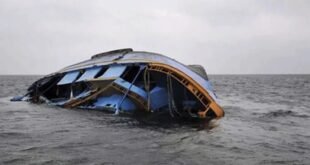In May, Europe’s gas imports from Russia exceeded supplies from the United States for the first time in nearly two years, despite the region’s efforts to wean itself off Russian fossil fuels after the full-scale invasion of Ukraine.
While one-off factors drove the turnaround, it highlights the difficulty of further reducing Europe’s dependence on Russian gas, as several Eastern European countries continue to rely on imports from their neighbors.

«It is surprising to see the market share of Russian gas and [liquefied natural gas] a centimeter higher in Europe after everything we have been through and all the efforts made to decouple and reduce risks in energy supply,” said Tom Marzec-Manser, head of gas analysis at consultancy ICIS.
Following Russia’s full-scale invasion of Ukraine in February 2022, Moscow cut gas supplies to Europe and the region increased imports of LNG, which is shipped on specialized vessels with the United States as main supplier.
The United States overtook Russia as a gas supplier to Europe in September 2022 and by 2023 accounts for about a fifth of the region’s supply.
But last month, gas and LNG shipments through Russian pipelines accounted for 15% of total supply to the EU, UK, Switzerland, Serbia, Bosnia-Herzegovina and North Macedonia, according to ICIS data.
LNG from the US accounted for 14% of supply in the region, the lowest level since August 2022, according to ICIS data.
The turnaround comes amid a general increase in European imports of Russian LNG, despite several EU countries pushing to impose sanctions on them.
As of mid-2022, Russia stopped sending gas through pipelines connecting it to northwestern Europe, but continues to deliver supplies via pipelines through Ukraine and Turkey.
May flows were affected by one-time factors, including an outage at a major U.S. LNG export facility, while Russia sent more gas through Turkey ahead of scheduled maintenance in June. Gas demand in Europe also remains relatively weak, with storage levels near record highs for this time of year.
The turnaround is “not likely to last,” ICIS’s Marzec-Manser said, as Russia will be able to ship LNG to Asia via the Northern Sea Route in the summer. That will likely reduce the amount sent to Europe, while U.S. LNG production has increased again, he said.
“Russia has limited flexibility to maintain this quota [in Europe] As requested [for gas] will increase next winter, while overall US LNG production continues to grow as additional new capacity arrives on the global market later this year,” he added.
The transit agreement between Ukraine and Russia also expires this year, putting flows along the route at risk.
While one-off factors drove the turnaround, it highlights the difficulty of further reducing Europe’s dependence on Russian gas, as several Eastern European countries continue to rely on imports from their neighbors.
«It is surprising to see the market share of Russian gas and [liquefied natural gas] a centimeter higher in Europe after everything we have been through and all the efforts made to decouple and reduce risks in energy supply,” said Tom Marzec-Manser, head of gas analysis at consultancy ICIS.
Following Russia’s full-scale invasion of Ukraine in February 2022, Moscow cut gas supplies to Europe and the region increased imports of LNG, which is shipped on specialized vessels with the United States as main supplier.
The United States overtook Russia as a gas supplier to Europe in September 2022 and by 2023 accounts for about a fifth of the region’s supply.
But last month, gas and LNG shipments through Russian pipelines accounted for 15% of total supply to the EU, UK, Switzerland, Serbia, Bosnia-Herzegovina and North Macedonia, according to ICIS data.
LNG from the US accounted for 14% of supply in the region, the lowest level since August 2022, according to ICIS data.
The turnaround comes amid a general increase in European imports of Russian LNG, despite several EU countries pushing to impose sanctions on them.
As of mid-2022, Russia stopped sending gas through pipelines connecting it to northwestern Europe, but continues to deliver supplies via pipelines through Ukraine and Turkey.
May flows were affected by one-time factors, including an outage at a major U.S. LNG export facility, while Russia sent more gas through Turkey ahead of scheduled maintenance in June. Gas demand in Europe also remains relatively weak, with storage levels near record highs for this time of year.
The turnaround is “not likely to last,” ICIS’s Marzec-Manser said, as Russia will be able to ship LNG to Asia via the Northern Sea Route in the summer. That will likely reduce the amount sent to Europe, while U.S. LNG production has increased again, he said.
“Russia has limited flexibility to maintain this quota [in Europe] As requested [for gas] will increase next winter, while overall US LNG production continues to grow as additional new capacity arrives on the global market later this year,” he added.
The transit agreement between Ukraine and Russia also expires this year, putting flows along the route at risk.
The European Commission supports efforts to establish an investment plan to expand gas pipeline capacity in the Southern Gas Corridor between the EU and Azerbaijan.
A senior EU official said supplies through the route are currently insufficient to replace the 14 billion cubic meters of Russian gas that currently flows through Ukraine to the EU each year.
European Energy Commissioner Kadri Simson said she raised concerns about LNG being diverted from Europe to meet demand in Asia during a trip to Japan this month.
He said Tokyo and Brussels had set up an “early warning system” to monitor LNG shortages and agreed that both should pursue energy-saving measures.
“The EU stands ready to buffer any adverse supply or demand events in global gas markets,” he added. “Our gas storage remains at record levels [and] our gas demand has stabilized at record low levels, down 20% compared to 2021.” [Financial Times]
The May report, after Russia overtook the United States as a gas supplier to Europe, appeared first on TheConclaveNg.
 JamzNG Latest News, Gist, Entertainment in Nigeria
JamzNG Latest News, Gist, Entertainment in Nigeria









